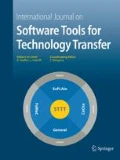Abstract
The term intelligent transportation systems (ITS) refers to information and communication technology (applied to transport infrastructure and vehicles) that improve transport outcomes such as transport safety, transport productivity, travel reliability, informed travel choices, social equity, environmental performance and network operation resilience. The importance of ITS is increasing as novel driverless/pilotless applications are emerging. This special issue addresses the application of formal methods to model and analyze complex systems in the context of ITS and in particular in the field of railway control systems. In fact, modelling and analysis activities are very important to optimize system life-cycle in the design, development, verification and operational stages, and they are essential whenever assessment and certification is required by international standards.
Similar content being viewed by others
References
Bjørner, D.: New results and trends in formal techniques and tools for the development of software for transportation systems: a review. In: Proceedings 4th Symposium on Formal Methods for Railway Operation and Control Systems (FORMS03), LHarmattan Hongrie, Budapest (2003)
European Committee for Electrotechnical Standardization. CENELEC EN50128. Railway applications-communication, signalling and processing systems-software for railway control and protection systems (2011)
ERTMS. http://www.ertms.net
Fantechi, A.: The role of formal methods in software development for railway applications. In: Chapter 12 of Francesco Flammini (ed) Railway safety, reliability, and security: technologies and systems engineering, pp. 282–297. IGI Global (2012)
Fantechi, A., Fokkink, W., Morzenti, A.: Some trends in formal methods applications to railway signaling. In: Gnesi, S., Margaria, T. (eds) Formal methods for industrial critical systems: a survey of applications. IEEE Computer Society Press, Washington, DC (2013)
Fantechi, A.: Twenty-five years of formal methods and railways: what next? In: SEFM Workshops, LNCS 8368, pp. 167–183 (2013)
Ferrari, A., Spagnolo, G.O., Martelli, G., Menabeni, S.: From commercial documents to system requirements: an approach for the engineering of novel CBTC solutions (2014)
Haxthausen, A.E.: Automated generation of formal safety conditions from railway interlocking tables (2014)
Iliasov, A., Romanovsky, A.: SafeCap domain language for reasoning about safety and capacity. Newcastle University, Computing Science, Technical Report Series, CS-TR-1352 (2012)
Institute of Electrical and Electronics Engineers. IEEE Standard for Communications Based Train Control (CBTC) Performance and Functional Requirements. IEEE Std 1474.1-2004.
James, P., Moller, F., Nguyen, H.N., Roggenbach, M., Schneider, S., Treharne, H.: Techniques for modelling and verifying railway interlockings (2014)
Marrone, S., Flammini, F., Mazzocca, N., Nardone, R., Vittorini, V.: Towards model-driven V&V assessment of railway control systems (2014)
Pascoe, R.D., Eichorn, T.N.: What is communication-based train control? IEEE Veh. Technol. Mag. 4(4), 16–21 (2009)
Peters, J.C., Frittelli, J.: Positive train control (PTC): overview and policy issues, Congressional Research Service Report R42637 (2012)
Flammini, F., Marrone, S., Mazzocca, N., Nardone, R., Vittorini, V.: Model-driven V&V processes for computer based control systems: a unifying perspective. In: ISoLA12-Track on Formal Methods for Intelligent Transportation Systems. Lecture Notes in Computer Science, vol. 7610, pp. 190–204 (2012)
Gigante, G., Pascarella, D.: Formal methods in avionic software certification: the DO-178C perspective. In: ISoLA12-Track on formal methods for intelligent transportation systems. Lecture Notes in Computer Science, vol. 7610, pp. 205–215 (2012)
Ferrari, A., Spagnolo, G.O., Martelli, G., Menabeni, S.: Product line engineering applied to CBTC systems development. In: ISoLA12-Track on Formal Methods for Intelligent Transportation Systems. Lecture Notes in Computer Science, vol. 7610, pp. 216–230 (2012)
Marrone, S., Nardone, R., Orazzo, A., Petrone, I., Velardi, L.: Improving verification process in driverless metro systems: the MBAT project. In: ISoLA12-Track on Formal Methods for Intelligent Transportation Systems. Lecture Notes in Computer Science, vol. 7610, pp. 231–245 (2012)
Winter, K.: Optimising ordering strategies for symbolic model checking of railway interlockings. In: ISoLA12-Track on Formal Methods for Intelligent Transportation Systems. Lecture Notes in Computer Science, vol. 7610, pp. 246–260 (2012)
Haxthausen, A.E.: Automated generation of safety requirements for railway interlocking systems. In: ISoLA12-Track on Formal Methods for Intelligent Transportation Systems. Lecture Notes in Computer Science, vol. 7610, pp. 262–275 (2012)
Fantechi, A.: Distributing the challenge of model checking interlocking control tables. In: ISoLA12-Track on Formal Methods for Intelligent Transportation Systems. Lecture Notes in Computer Science, vol. 7610, pp. 276–289 (2012)
Author information
Authors and Affiliations
Corresponding author
Rights and permissions
About this article
Cite this article
Fantechi, A., Flammini, F. & Gnesi, S. Formal methods for railway control systems. Int J Softw Tools Technol Transfer 16, 643–646 (2014). https://doi.org/10.1007/s10009-014-0342-1
Published:
Issue Date:
DOI: https://doi.org/10.1007/s10009-014-0342-1




